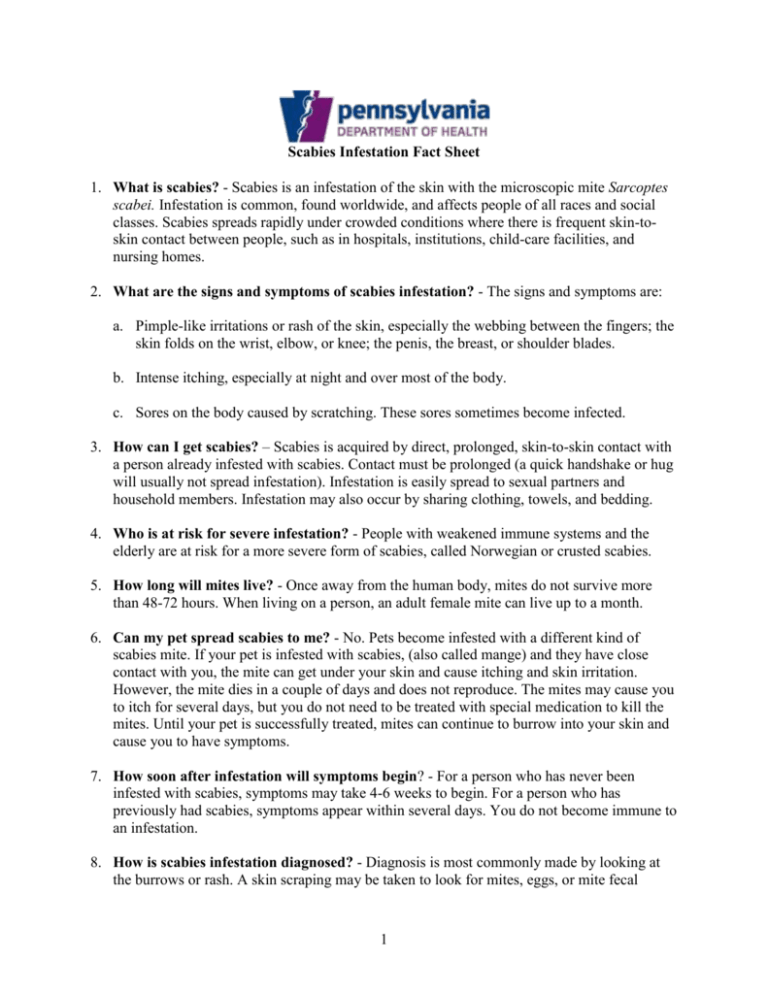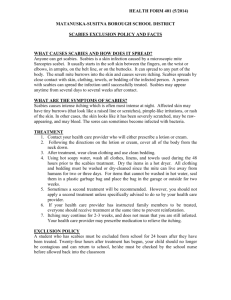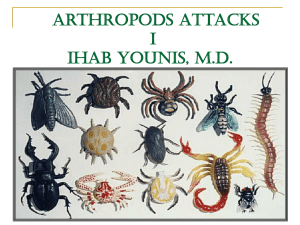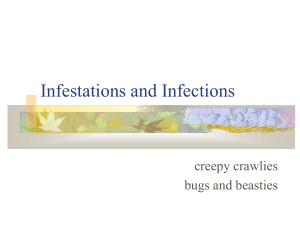Scabies Infestation Fact Sheet
advertisement

Scabies Infestation Fact Sheet 1. What is scabies? - Scabies is an infestation of the skin with the microscopic mite Sarcoptes scabei. Infestation is common, found worldwide, and affects people of all races and social classes. Scabies spreads rapidly under crowded conditions where there is frequent skin-toskin contact between people, such as in hospitals, institutions, child-care facilities, and nursing homes. 2. What are the signs and symptoms of scabies infestation? - The signs and symptoms are: a. Pimple-like irritations or rash of the skin, especially the webbing between the fingers; the skin folds on the wrist, elbow, or knee; the penis, the breast, or shoulder blades. b. Intense itching, especially at night and over most of the body. c. Sores on the body caused by scratching. These sores sometimes become infected. 3. How can I get scabies? – Scabies is acquired by direct, prolonged, skin-to-skin contact with a person already infested with scabies. Contact must be prolonged (a quick handshake or hug will usually not spread infestation). Infestation is easily spread to sexual partners and household members. Infestation may also occur by sharing clothing, towels, and bedding. 4. Who is at risk for severe infestation? - People with weakened immune systems and the elderly are at risk for a more severe form of scabies, called Norwegian or crusted scabies. 5. How long will mites live? - Once away from the human body, mites do not survive more than 48-72 hours. When living on a person, an adult female mite can live up to a month. 6. Can my pet spread scabies to me? - No. Pets become infested with a different kind of scabies mite. If your pet is infested with scabies, (also called mange) and they have close contact with you, the mite can get under your skin and cause itching and skin irritation. However, the mite dies in a couple of days and does not reproduce. The mites may cause you to itch for several days, but you do not need to be treated with special medication to kill the mites. Until your pet is successfully treated, mites can continue to burrow into your skin and cause you to have symptoms. 7. How soon after infestation will symptoms begin? - For a person who has never been infested with scabies, symptoms may take 4-6 weeks to begin. For a person who has previously had scabies, symptoms appear within several days. You do not become immune to an infestation. 8. How is scabies infestation diagnosed? - Diagnosis is most commonly made by looking at the burrows or rash. A skin scraping may be taken to look for mites, eggs, or mite fecal 1 matter to confirm the diagnosis. If a skin scraping or biopsy is taken and returns negative, it is possible that you may still be infested. Typically, there are fewer than 10 mites on the entire body of an infested person; this makes it easy for an infestation to be missed. 9. Can scabies be treated? - Yes. Several lotions are available to treat scabies. Always follow the directions provided by your physician or the directions on the package insert. Apply lotion to a clean body from the neck down to the toes and leave on overnight (8 hours). After 8 hours, take a bath or shower to wash off the lotion. Put on clean clothes. All clothes, bedding, and towels used by the infested person two days before treatment should be washed in hot water; dry in a hot dryer. A second treatment of the body with the same lotion may be necessary 7-10 days later. Pregnant women and children are often treated with milder scabies medications. 10. Who should be treated for scabies? - Anyone who is diagnosed with scabies, as well as his or her sexual partners and persons who have close, prolonged contact to the infested person should also be treated. If your health care provider has instructed family members to be treated, everyone should receive treatment at the same time to prevent reinfestation. 11. How soon after treatment will I feel better? - Itching may continue for 2-3 weeks, and does not mean that you are still infested. Your health care provider may prescribe additional medication to relieve itching if it is severe. No new burrows or rashes should appear 24-48 hours after effective treatment. 12. For more information about Scabies: http://www.cdc.gov/scabies/ This fact sheet provides general information. Please contact your physician and/or veterinarian for specific clinical information related to you or your animal. 2











